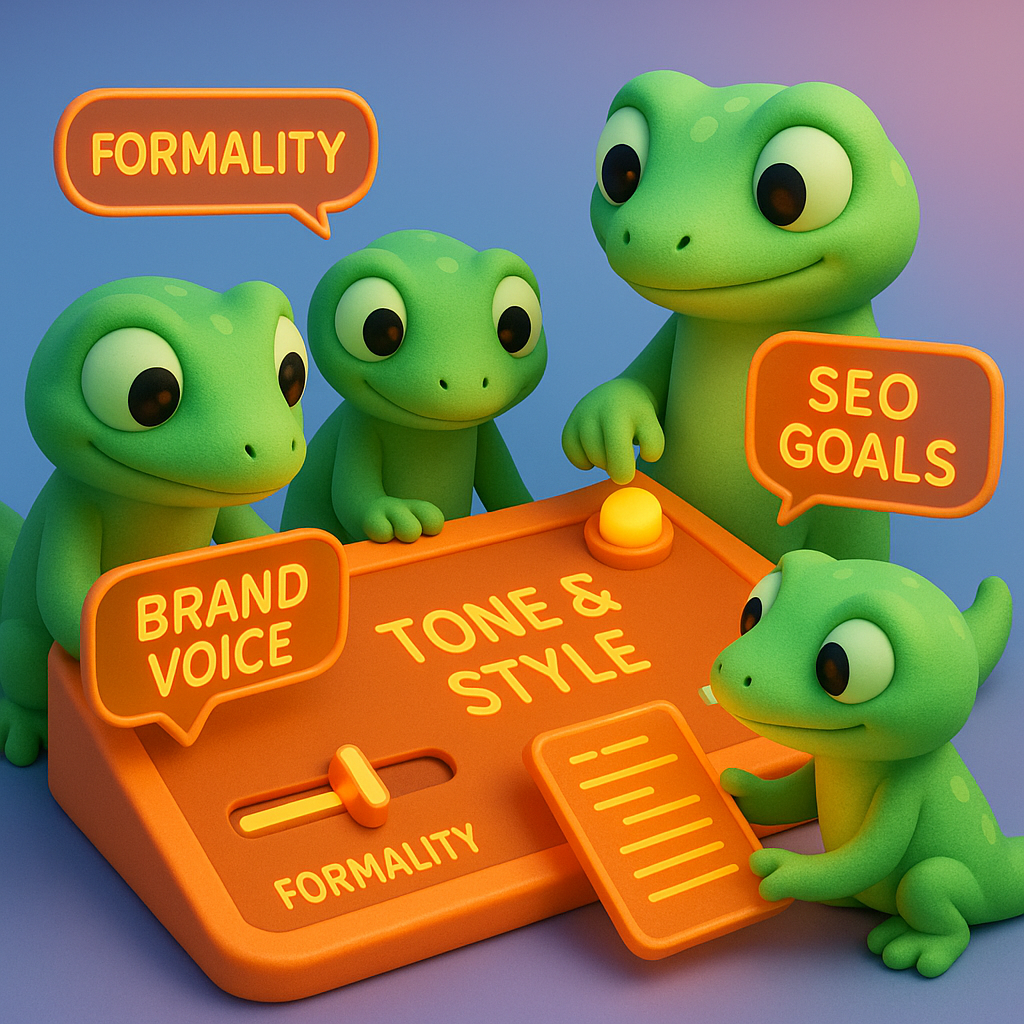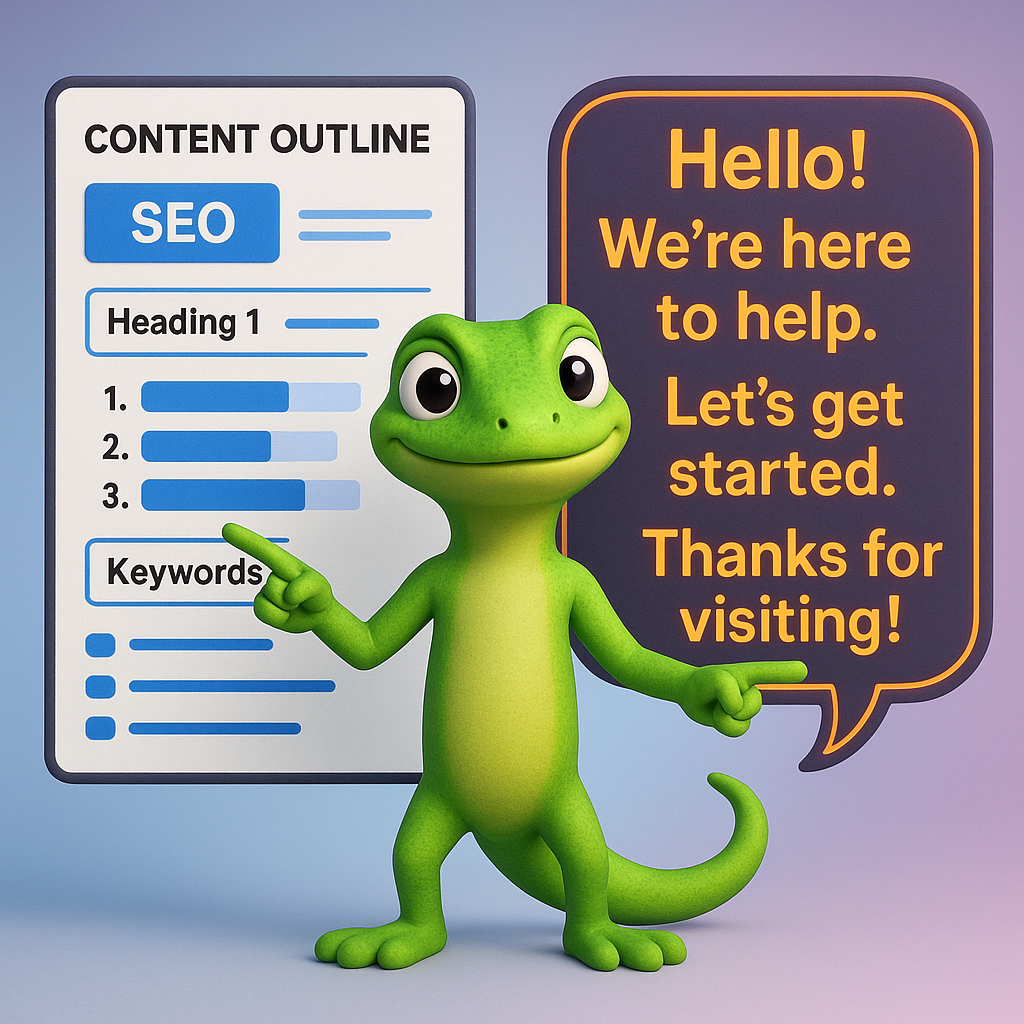AI Content Tone and Style Adjustment for Precise Brand Alignment
When it comes to AI-generated marketing content, having the right tone and style isn’t just desirable—it’s essential for brand alignment and SEO performance. As AI continues to transform content creation, marketing leaders need precise control over how their content speaks to audiences while maintaining SEO effectiveness.
Understanding AI Content Tone and Style Challenges
AI tools excel at generating content quickly, but without proper guidance, they often miss the mark on brand voice and emotional resonance. The challenge for marketing leaders lies in maintaining brand consistency while leveraging AI’s efficiency for SEO-driven content creation.
According to industry data, 42% of businesses now use AI for long-form content creation, with 70% leveraging tools like ChatGPT to accelerate production. However, 62% of marketers report issues with maintaining consistent brand voice in AI-generated content.
Strategic Methods for Tone and Style Adjustment
Hybrid Workflows for Brand Voice Precision
The most effective approach combines AI drafting with human editing for strategic oversight. This layered method allows marketing teams to:
- Use AI for initial content structure and SEO elements
- Apply human editing for brand voice refinement
- Implement feedback loops to continuously train AI systems
ContentGecko employs specialized AI agents that work through multiple content creation stages, allowing marketing leaders to intervene at various points to ensure brand consistency while maintaining SEO optimization.
Structured Content Briefs with Style Parameters
AI-powered SEO tools now offer sophisticated style controls:
- Tone sliders: Adjust formality, urgency, or empathy levels
- Jargon filters: Specify acceptable technical complexity
- Brand voice templates: Predefine style guidelines (contractions, humor, etc.)
Using AI content creation tools with these capabilities enables marketing teams to create detailed briefs that produce on-brand content consistently. For example, a financial services company might set their tone parameters to “authoritative but approachable,” with jargon filters allowing industry terms their audience understands while avoiding overly technical language.

Balancing SEO Effectiveness with Brand Tone
Layered Content Structures
Modern AI SEO content requires a strategic approach to balance search visibility with brand voice:
- Concise answers: Optimize for AI overviews and featured snippets
- Detailed body content: Focus on traditional SEO and keyword integration
- Cited facts: Enhance credibility for both human readers and AI systems
This layered approach, as detailed in natural language processing for SEO, allows content to perform well across traditional search and newer AI-driven platforms. One financial services blog saw a 32% increase in featured snippet appearances after implementing this structure while maintaining their professional but conversational brand voice.
Technical SEO Integration
Maintaining brand voice doesn’t mean sacrificing technical SEO elements:
- Use schema markup (FAQPage, HowTo) and structured data
- Incorporate natural keyword placement without compromising readability
- Embed multimedia elements to boost engagement metrics
These technical optimizations, implemented through AI content optimization tools, ensure content performs well in search while maintaining stylistic integrity. The key is integrating keywords naturally within your established voice rather than forcing awkward phrases that disrupt your brand’s distinctive tone.

Practical Implementation for Marketing Leaders
Multi-Stage Content Refinement Process
ContentGecko’s workflow demonstrates how marketing leaders can implement tone and style adjustments at multiple stages:
- Brief generation: Set SEO goals and brand voice parameters
- Research gathering: Collect facts that align with brand positioning
- Draft generation: Create initial content with AI
- Editing: Refine for content quality and brand alignment
- Finalization: Optimize for both traditional SEO and emerging AI systems
This approach allows for what marketing experts call “progressive refinement”—starting with SEO fundamentals and layering in brand voice elements at each stage. As one ContentGecko user noted, “AI briefs are more comprehensive than manual ones—we save half a day per piece while maintaining our distinctive voice.”
Performance Tracking and Adjustment
To ensure tone and style adjustments drive business results:
- Monitor organic traffic changes through Google Search Console integration
- Track ranking improvements for target keywords
- Calculate ROI using tools like ContentGecko’s SEO ROI calculator
- Analyze user engagement metrics to validate style effectiveness
Marketing teams using this methodology have reported 27% higher organic traffic through properly optimized, brand-aligned content. These performance insights create a feedback loop that informs future content adjustments, allowing for continuous refinement of both SEO strategy and brand voice parameters.
Evolving Optimization Approaches
As search continues to evolve, marketing leaders need to understand the differences between traditional SEO and newer optimization approaches:
- SEO (Search Engine Optimization): Traditional keyword and link-based strategy
- AEO (Answer Engine Optimization): Optimizing for direct answers in AI assistants
- GEO (Generative Engine Optimization): Creating content for citation in AI-generated responses
The difference between AEO, GEO, and SEO highlights how tone and style requirements vary across these approaches. For example, AEO content often benefits from a more conversational tone with clear, definitive statements, while traditional SEO content might employ a more nuanced, keyword-rich approach.
Google itself has emphasized this shift, noting that brands should “focus on unique, valuable content that fulfills user needs. This aligns with AI search experiences and traditional SEO.” This guidance underscores the importance of maintaining authentic brand voice while adapting to evolving search paradigms.
Tool Selection for Tone and Style Control
When evaluating AI tools for content tone and style adjustment, prioritize:
- Specialized vs. general-purpose AI: Tools like ContentGecko’s AI writer offer more refined control than general AI
- Integration capabilities: Ensure tools work with existing content workflows
- Brand voice preservation: Look for explicit tone and style controls
- Fact-checking abilities: Verify that content remains accurate while maintaining style
- Scalability: Ensure the solution grows with your content needs
Marketing directors who have implemented specialized SEO AI tools report “undeniable ROI within a month” compared to generic AI solutions. The difference lies in purpose-built features that understand the nuances of both SEO requirements and brand tone specifications.
A practical example comes from topic clustering approaches, where tools like free keyword clustering tools help structure content hierarchically. This organization not only improves SEO but also provides a framework for maintaining consistent brand voice across related content pieces.
TL;DR
AI content tone and style adjustment requires strategic approaches combining specialized tools, human oversight, and layered content structures. Marketing leaders should implement multi-stage workflows that allow for brand voice refinement while maintaining SEO effectiveness. By leveraging specialized AI tools and performance tracking, teams can create content that maintains precise brand alignment while driving measurable organic traffic growth. The most successful implementations balance technical SEO requirements with authentic brand voice, adapting to evolving search paradigms without sacrificing the distinctive tone that connects with target audiences.
